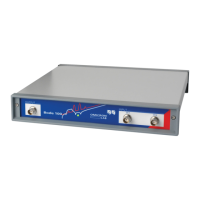9
Introduction
1 Introduction
1.1 Overview
The Bode 100 is a multifunctional test & measurement instrument designed for
professionals such as scientists, engineers and teachers engaged in the field of
electronics. Its concept – universal hardware controlled by the
Bode Analyzer Suite software running on a computer – makes the Bode 100 an
efficient and flexible solution for a wide spectrum of applications including:
• Gain/Phase measurements
The Bode 100 measures the gain and phase of passive and active electronic
circuits as well as complex electronic systems such as closed-loop control
systems, video systems and RF equipment.
• Impedance/Reflection measurements
The Bode 100 measures the impedance, admittance and reflection
coefficient of passive and active electronic circuits. An internal bridge allows
performing measurements by just connecting the device under test (DUT) to
the Bode 100 source.
• Frequency Sweep measurements
In addition to single frequency measurements, the Bode 100 performs
measurements in the Frequency Sweep mode.
In this measurement mode, the Bode 100 is capable of measuring the
complex gain, reflection coefficient and impedance of the DUT. The results
are displayed as a function of the frequency in various display formats such
as group delay curves or Smith charts.
• Frequency Sweep (External Coupler) measurements
In this measurement mode you can measure the complex impedance,
admittance and reflection coefficient of the DUT by using an external
directional coupler or other external measurement bridge. Typical application
examples include measurements of broadcast antennas and impedance
measurements with signal levels above 20 mW.
The measurement results are available on your computer for processing and/or
documentation.
The Bode 100 includes a DDS (direct digital synthesis) signal source with
adjustable level and frequency for excitation of the DUT, two receivers
processing the DUT’s response and a microcontroller. A DC power converter
generates voltages for powering the circuitry involved. For the basic block
diagram of the Bode 100, see Figure 1-1: "Block diagram" on page 10.
The Bode Analyzer Suite runs on a computer connected to the Bode 100
through USB interface.

